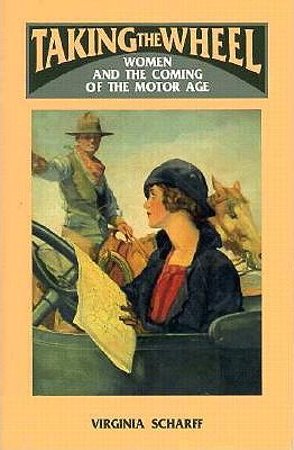
When Virginia Scharff submitted her dissertation in 1987, it was hard to imagine it would evolve into a book that would forever change the course of women’s automotive history scholarship. At the time it was written there was very little research devoted to the history of cars or car culture. That which existed was – not surprisingly – written about, by, and for men. However, as a young and developing historian, Scharff joined the wave of feminist scholars who began “writing women into history” during the late 1970s. Like those before her, she desired to examine an aspect of women’s lives which had heretofore been invisible. Because scholarship on women’s automobility was nonexistent, Scharff had some difficulty finding resources on which to base her research. Although she struggled to find data, Scharff’s determination and diligence paid off. Taking the Wheel: Women and the Coming of the Motor Age, published in 1991, was groundbreaking not only for its subject matter, but because it challenged and dispelled the “common knowledge” about women’s relationship to the automobile.
In the early motor age, automobiles were handcrafted, costly, and electric with limited range and power. Consequently, they were not taken seriously as modes of transportation but rather, served as expensive playthings for the rich. However, after the development of the gasoline-powered engine, and Henry Ford’s implementation of the assembly line, automobiles became faster, cheaper, less refined, and available and accessible to “every man.” The growing popularity of the gasoline-powered automobile in the early twentieth century resulted in a significant loss of market share for the manufacturers of electric cars. Seeking to maintain or increase its consumer base, the electric was repositioned from a symbol of wealth and status to a vehicle particularly suited for the woman driver. The gasoline automobile, on the other hand, as noisy, dirty, rough, and difficult to operate – as well as fast and powerful – was positioned as the ultimate man’s car.
Until Scharff entered the scene, students and scholars of automotive history uniformly accepted the notion that, because the electric had the feminine qualities women desired in a car, it was, in fact, women’s transportation choice. The report that Henry Ford purchased an electric for his wife Clara seemed to confirm this widely held view. However, as Scharff discovered in her research, the electric was promoted as the woman’s car not because women innately desired it, but because of the potential repercussions of women’s enthusiasm for the gasoline-powered automobile. Yet despite the efforts of automakers to market the electric as the “woman’s car,” female drivers of the growing middle class set their sights on the power and performance the masculine gas-powered automobile could provide. Seeking horizons beyond the confinement of domesticity, women envisioned automobility as the means to reach them. In the minds of many women, attainment of such lofty goals was not to be realized through the limited power of the meek electric, but rather, from behind the wheel of the noisy, dirty, and aggressive gasoline-powered automobile.
When the electric eventually disappeared from the roadways, and it became clear that the female motorist had set her sights on the gas-powered car, auto industry decision makers were faced with a conundrum. While automakers recognized the lucrative possibilities of a female consumer base, they also feared an appeal to the woman driver would damage the longstanding association between cars and masculinity. The solution was to call upon the “vast, immutable, reassuring differences between men and women” as the means to divide automotive use by gender (115). The large, powerful vehicle was marketed to the male head of the household. And by promoting the smaller, less powerful, more practical vehicle as form of domestic technology, a tool that enabled women to fulfill their prescribed roles as wives, mothers, consumers, and caretakers, automakers believed they could appeal to the female consumer without alienating men.
Scharff’s notion that women’s car choices threatened the status quo – so much so that automakers had to develop marketing strategies to contain the woman driver – was both a revelation and confirmation to future scholars of women’s automobility. It changed the way historians and cultural studies scholars approached women’s relationship to the automobile. It altered how cars are marketed to women. And most importantly, it motivated scholars to continually question and challenge “common knowledge” about women and cars.
Although Scharff has since moved on from women’s automobility to other topics in women’s social history, her influence on those who study gender and automobiles today is both significant and ongoing. Those of us who write about women and cars are forever grateful for her determined and tireless efforts – while a young PhD student – to recover a missing – and revelatory – part of automotive history.
Do you have a favorite automotive author? Are you interested in automotive history, automotive advice, or just a good story about cars? Your comments are welcome.